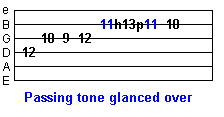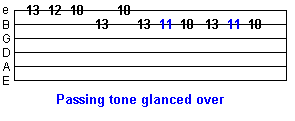Home
> Scales
> Passing
Tones
Text lesson
When learning scales, you not only need to memorise how their patterns form on the fretboard, but also which chords they work over.
When you begin exploring how scale tones interact with the chords you're playing over, you soon realise that certain tones within the scale don't fit as well as others. These dissonant or non-chord scale tones are commonly known as passing tones and, as you'll hear, we can still use them, just in a different way.
In this lesson I'm going to show you how to identify these passing tones so you can then work on integrating them more effectively and fuidly in your solos. This is as much an ear training exercise as it is a theory lesson.
Remember, you can learn many scales in the scales section, and each have their own "passing tones" but I'll show you some specific examples here as we go.
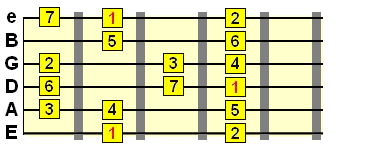
1 W 2 W 3 H 4 W 5 W 6 W 7 H 1
We can see that the major scale consists of 7 tones. We can also tell from the existence of the major 3rd that this scale will work over major chords (although the name "major scale" is a bit of a giveaway!).
Now, when getting to know scales, one method I find useful is to record myself playing a backing chord in the same key and then playing each tone from the scale over that chord to hear how they harmonise as individual notes.
In this example, we're using the B major scale over a B major chord (this means our scale root needs to be on B), playing each of the tones of the major scale from 1 to 7.
What this will do is train your ear to pick out any scale tones that don't sit right over its root chord, known as non-chord tones, so when you come to soloing, you will treat these as passing tones, which I'll explain how to use in a minute.
There is another way to identify these tones without hearing anything, but actually hearing the difference between dissonance and harmony is really important when first learning this stuff. There's a simple B major backing track which you can download below so you can get a feel for this yourself.
B major backing track
So let's listen to how each tone of the major scale sounds over its related major chord. I'll start on the D string root note for a higher register.
1 Also known as the root note, which defines the tonal center of our scale and the root of the major triad - click to hear
2 Often used as an added note in major chords - click to hear
3 Also known as the major 3rd, and part of the major triad. This is the tone that makes it a major scale - click to hear
4 Now, here is our first passing tone. You can tell because it doesn't sound as relaxed against the backing chord as the other tones - click to hear
There's an air of unresolved tension about it. We can mark this up and come back to it later. It's worth noting that the 4th is rarely added to the major triad, but there are exceptions such as using the octave of the 4th (known as the 11th) which tends to sit better against the major triad.
5 Part of the major triad - click to hear
6 Often used as an added note in major chords - click to hear
7 Also known as the major 7th, again, often used to extend the basic major triad - click to hear
...and then we're back to the root (1) again.
So it turns out, only one tone, the 4th, stood out as being unharmonious with our major chord. Now, there are two questions that arise from this simple discovery...
WHY is the 4th dissonant and not the other tones?
HOW can we use this tone, if at all?
Unfortunately, I don't have time to go into the why at the moment, although it's a fascinating subject (in my opinion) and certainly explored in great depth in the field of musicology.
But as far as playing this scale goes, how can we use the 4th if it has this dissonant quality?
We use it as a passing tone.
See, the best way to think of a passing tone is a tone you shouldn't hold onto or emphasise in your solos.
Listen again to how the 4th sounds if we emphasise it within a soloing phrase over the major chord of the same key...
Click to hear
It sounds unresolved.
But, since the 4th is essentially part of the major scale, we can, if we like, glance over it as part of a larger phrase between the more stable, harmonious tones we heard.
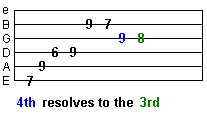
This is known as resolution. The passing tone provides an unresolved tension that is resolved to one of the more stable tones in the scale. The most stable tones in the major scale are the root, 3rd and 5th - and it's no surprise when you understand the root, 3rd and 5th make up the major triad! It's the foundation of the major chord.
I call these safe tones or resting tones.
So, going back to that resolution phrase, I've resolved the 4th, a passing tone, to the 3rd, a tone we can rest on harmoniously.
You could also resolve to other tones outside the major triad - the 2nd, 6th and 7th, with the 7th being the least resolved out of those 3, but these are specific flavours of this particular major scale, so you need to know for definite that these tones are compatible with the major chord being played in the background, especially if there are chord changes. We'll look more at that some other time. We need to walk before we can run!
This is known as the natural minor scale...
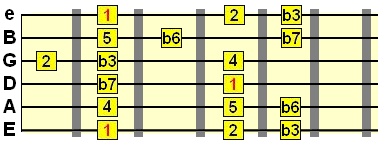
Its intervals are:
1 W 2 H b3 W 4 W 5 H b6 W b7 W 1
From the name of this scale we can tell it's a minor scale, so it'll work over minor chords, but if it was called something less obvious, we'd know it's a minor scale because of the flat 3rd, also known as the minor 3rd.
Let's go through the same process we did in the first example, but this time because it's a minor scale I'll be playing it over a minor chord. In this case it's D minor (click here for a D minor drone track similar to the B major one before so you can explore this scale).
Click to hear
The last bit I repeat in that clip is the passing tone of this scale. The flat 6th (b6).
As we learned before, we can still use this tone in a soloing harmony, but we need to avoid emphasising it over that tonic minor chord.
A good way to make use of passing tones is to use them in hammer on and pull off situations...
Or glanced over in a run...
The great thing about this knowledge is that it will come naturally as you learn more and more scales and investigate how they work over certain chords.
Learn More Guitar Scales
Using Passing Tones in Guitar Scales
Video lessonText lesson
When learning scales, you not only need to memorise how their patterns form on the fretboard, but also which chords they work over.
When you begin exploring how scale tones interact with the chords you're playing over, you soon realise that certain tones within the scale don't fit as well as others. These dissonant or non-chord scale tones are commonly known as passing tones and, as you'll hear, we can still use them, just in a different way.
In this lesson I'm going to show you how to identify these passing tones so you can then work on integrating them more effectively and fuidly in your solos. This is as much an ear training exercise as it is a theory lesson.
Remember, you can learn many scales in the scales section, and each have their own "passing tones" but I'll show you some specific examples here as we go.
Identifying passing tones in guitar scales
Let's start with the major scale. It always seems the most logical place to begin when studying scales.
1 W 2 W 3 H 4 W 5 W 6 W 7 H 1
We can see that the major scale consists of 7 tones. We can also tell from the existence of the major 3rd that this scale will work over major chords (although the name "major scale" is a bit of a giveaway!).
Now, when getting to know scales, one method I find useful is to record myself playing a backing chord in the same key and then playing each tone from the scale over that chord to hear how they harmonise as individual notes.
In this example, we're using the B major scale over a B major chord (this means our scale root needs to be on B), playing each of the tones of the major scale from 1 to 7.
What this will do is train your ear to pick out any scale tones that don't sit right over its root chord, known as non-chord tones, so when you come to soloing, you will treat these as passing tones, which I'll explain how to use in a minute.
There is another way to identify these tones without hearing anything, but actually hearing the difference between dissonance and harmony is really important when first learning this stuff. There's a simple B major backing track which you can download below so you can get a feel for this yourself.
B major backing track
So let's listen to how each tone of the major scale sounds over its related major chord. I'll start on the D string root note for a higher register.
1 Also known as the root note, which defines the tonal center of our scale and the root of the major triad - click to hear
2 Often used as an added note in major chords - click to hear
3 Also known as the major 3rd, and part of the major triad. This is the tone that makes it a major scale - click to hear
4 Now, here is our first passing tone. You can tell because it doesn't sound as relaxed against the backing chord as the other tones - click to hear
There's an air of unresolved tension about it. We can mark this up and come back to it later. It's worth noting that the 4th is rarely added to the major triad, but there are exceptions such as using the octave of the 4th (known as the 11th) which tends to sit better against the major triad.
5 Part of the major triad - click to hear
6 Often used as an added note in major chords - click to hear
7 Also known as the major 7th, again, often used to extend the basic major triad - click to hear
...and then we're back to the root (1) again.
So it turns out, only one tone, the 4th, stood out as being unharmonious with our major chord. Now, there are two questions that arise from this simple discovery...
WHY is the 4th dissonant and not the other tones?
HOW can we use this tone, if at all?
Unfortunately, I don't have time to go into the why at the moment, although it's a fascinating subject (in my opinion) and certainly explored in great depth in the field of musicology.
But as far as playing this scale goes, how can we use the 4th if it has this dissonant quality?
We use it as a passing tone.
See, the best way to think of a passing tone is a tone you shouldn't hold onto or emphasise in your solos.
Listen again to how the 4th sounds if we emphasise it within a soloing phrase over the major chord of the same key...
Click to hear
It sounds unresolved.
But, since the 4th is essentially part of the major scale, we can, if we like, glance over it as part of a larger phrase between the more stable, harmonious tones we heard.

This is known as resolution. The passing tone provides an unresolved tension that is resolved to one of the more stable tones in the scale. The most stable tones in the major scale are the root, 3rd and 5th - and it's no surprise when you understand the root, 3rd and 5th make up the major triad! It's the foundation of the major chord.
I call these safe tones or resting tones.
So, going back to that resolution phrase, I've resolved the 4th, a passing tone, to the 3rd, a tone we can rest on harmoniously.
You could also resolve to other tones outside the major triad - the 2nd, 6th and 7th, with the 7th being the least resolved out of those 3, but these are specific flavours of this particular major scale, so you need to know for definite that these tones are compatible with the major chord being played in the background, especially if there are chord changes. We'll look more at that some other time. We need to walk before we can run!
Passing tones in the natural minor scale
Let's look at another scale which makes use of passing tones. Remember, scales can have more than one passing tone, but the scale we're about to look at only has one, like the major scale.This is known as the natural minor scale...

Its intervals are:
1 W 2 H b3 W 4 W 5 H b6 W b7 W 1
From the name of this scale we can tell it's a minor scale, so it'll work over minor chords, but if it was called something less obvious, we'd know it's a minor scale because of the flat 3rd, also known as the minor 3rd.
Let's go through the same process we did in the first example, but this time because it's a minor scale I'll be playing it over a minor chord. In this case it's D minor (click here for a D minor drone track similar to the B major one before so you can explore this scale).
Click to hear
The last bit I repeat in that clip is the passing tone of this scale. The flat 6th (b6).
As we learned before, we can still use this tone in a soloing harmony, but we need to avoid emphasising it over that tonic minor chord.
A good way to make use of passing tones is to use them in hammer on and pull off situations...
Or glanced over in a run...
The great thing about this knowledge is that it will come naturally as you learn more and more scales and investigate how they work over certain chords.
| |
Tweet |
Stay updated and learn more
Sign up to the newsletter for updates and grab your free Uncommon Chords book
Sign up to the newsletter for updates and grab your free Uncommon Chords book
Learn More Guitar Scales





